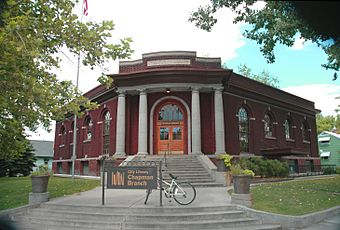Chapman Branch Library facts for kids
Quick facts for kids |
|
|
Chapman Branch Library
|
|
 |
|
| Location | 577 S. 900 West, Salt Lake City, Utah |
|---|---|
| Area | less than one acre |
| Built | 1918 |
| Built by | Ashton Improvement Co. |
| Architect | Don Carlos Young, Jr. |
| Architectural style | Classical Revival |
| NRHP reference No. | 80003918 |
| Added to NRHP | January 20, 1980 |
The Chapman Branch Library in Salt Lake City, Utah, is a historic building that has served its community for over a century. It was built in 1918 with money from the Carnegie Foundation, which helped build many libraries across the United States. This library is so important that it was added to the National Register of Historic Places in 1980, recognizing its special history and design.
What is a Carnegie Library?
A Carnegie library is a public library built with money donated by Scottish-American businessman and philanthropist Andrew Carnegie. He believed that access to books and knowledge could help people improve their lives. Between 1883 and 1929, Carnegie and his foundation helped build over 2,500 libraries around the world, including many in the United States. These libraries were often designed to be beautiful and welcoming places for everyone. The Chapman Branch Library received $25,000 from the Carnegie Foundation to help make it a reality.
About the Library's Name
The Chapman Branch Library is named after a very important person in Salt Lake City's library history: Annie E. Chapman. She was the very first librarian for the Salt Lake City public library system. Naming the library after her was a way to honor her dedication and hard work in helping people access books and information.
Building Design and Importance
The Chapman Branch Library was designed by a talented architect named Don Carlos Young, Jr.. He created an L-shaped building in the Classical Revival style. This style often uses elements inspired by ancient Greek and Roman buildings, like grand entrances and balanced designs. Don Carlos Young, Jr. also designed parts of the University of Utah campus and several other important buildings.
When the library first opened, people were very excited about it. A local newspaper, the Deseret News, wrote that the library would be "the beginning of the greatest social, intellectual and civic development the west side of the city has yet known." This shows how much hope and importance the community placed on this new library as a center for learning and growth.



